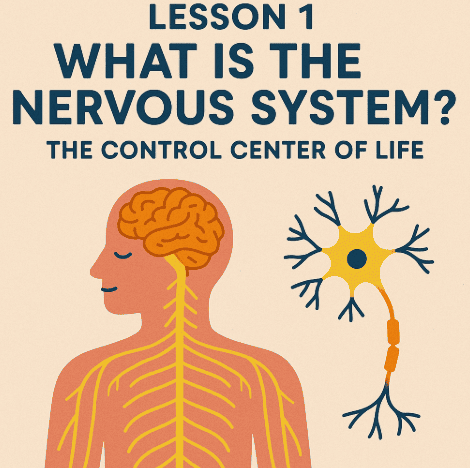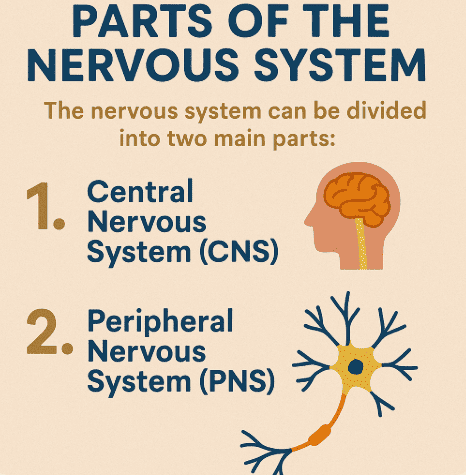
Your body is like a giant spaceship 🛸.
Muscles are the engines, bones are the structure, the heart is the fuel pump, and your digestive system is the food processor. But none of these parts can work on their own.
Something must coordinate (organize and control) them, just like the captain coordinates all parts of a spaceship. That “captain” is your nervous system.
🏗️ What Exactly is a System?
Before we even talk about the nervous system, let’s break down the word “system.”
A system is a group of parts that work together to do a job. For example:
-
A car engine has many parts, but together, they form the “engine system.”
-
Your school has teachers, students, classrooms, and books—it is an “education system.”
-
In your body, you have many systems: the digestive system (that breaks down food), the circulatory system (that pumps blood), the respiratory system (that brings in oxygen), and of course, the nervous system (that controls everything).
So, when we say “nervous system,” we mean:
👉 A group of body parts that work together to control, guide, and manage everything you do.
🧠 What is the Nervous System?
The nervous system is your body’s control and communication network.
It is made of:
-
The Brain – the “boss” that makes decisions.
-
The Spinal Cord – the “main highway” that carries signals between the brain and the rest of the body.
-
Nerves – the “wires” that spread out all over your body, carrying messages.
-
Nerve Cells (Neurons) – the tiny “workers” that pass signals using electricity ⚡ and chemicals.
Together, they allow you to:
-
Move your body when you want to 🏃♂️.
-
Feel things like hot, cold, soft, rough, pain, or tickles 👋.
-
Think, remember, imagine, and dream 🌌.
-
Control automatic things like your heartbeat ❤️ and breathing 🌬️.
Without the nervous system, your body would be like a phone with no battery—present, but lifeless.
⚡ How Does the Nervous System Work?
Think of your nervous system as a super-fast communication network.
Imagine you touch something hot, like a stove 🔥. Here’s what happens:
-
Your skin senses the heat.
-
Nerves in your skin send an “emergency signal” up to the spinal cord.
-
The spinal cord quickly passes it to the brain.
-
The brain says, “Ouch! That’s dangerous!”
-
A message is sent back through nerves to your hand muscles.
-
Your hand pulls away immediately.
This whole process happens in a fraction of a second ⏱️—much faster than you can think. That’s why you sometimes pull your hand back before you even realize you touched something hot!
🗺️ Parts of the Nervous System (A Simple Map)
The nervous system can be divided into two main parts:

1. Central Nervous System (CNS)
This is the main office. It includes the brain and the spinal cord. It makes decisions and sends commands.
2. Peripheral Nervous System (PNS)
This is the delivery system. It includes all the nerves that branch out from the spinal cord to every part of your body—your fingers, toes, heart, stomach, eyes, and more.
So, CNS = Boss.
PNS = Messengers that deliver the boss’s orders.
🎮 An Everyday Example
Let’s pretend your body is a video game console 🎮.
-
The brain is the game’s CPU (central processing unit). It decides what happens in the game.
-
The spinal cord is the main cable connecting the console to the TV.
-
The nerves are like all the smaller wires that connect to controllers, speakers, and sensors.
-
The neurons are like the tiny signals of electricity inside the wires, carrying the information.
If any part of this network fails, the game will freeze, glitch, or not run properly.
🧩 Why is it Called the “Nervous” System?
The word “nervous” comes from nerves, which are bundles of tiny wires carrying messages. But there’s a fun twist: when we say a person feels “nervous” (like before an exam), we also mean that their nervous system is extra active—sending lots of signals like “sweat more,” “heart beat faster,” “breathe quicker.”
So the name “nervous system” actually makes sense in both science and feelings.
🔬 The Nervous System: Smallest to Largest
To really understand the nervous system, let’s go from tiny to big:
So, neurons → nerves → spinal cord → brain → nervous system.
🕹️ Fun Fact: Faster than the Internet
Messages in your nervous system can travel up to 120 meters per second (that’s about 430 km/h). That’s faster than most cars drive on a highway! Compare that to internet speed—your body’s “Wi-Fi” is actually super quick.
🧠 Why Do We Need a Nervous System?
Let’s imagine if we did NOT have a nervous system:
-
You could not move on your own.
-
You could not feel anything.
-
You would not think, remember, or dream.
-
Your heart would stop because no signals tell it to beat.
-
You would not even breathe.
In short: No nervous system = No life.
That’s why it’s called the control center of life.
🌌 The Nervous System as a Symphony
Picture an orchestra 🎻🥁🎺. Each instrument plays its part, but if there is no conductor, the music would be noise. The nervous system is like the conductor, keeping all organs, muscles, and senses working in perfect timing.
Your heartbeat, your breathing, your thoughts, your movements—all are the “music” of your body’s orchestra.